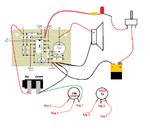Audioguru
Advanced Member level 7
- Joined
- Jan 19, 2008
- Messages
- 9,457
- Helped
- 2,151
- Reputation
- 4,302
- Reaction score
- 2,008
- Trophy points
- 1,393
- Location
- Toronto area of Canada
- Activity points
- 59,720
Yes, your photo shows the output capacitor connected backwards that might have destroyed it, the speaker and the LM386.
Your new parts layout shows the Jfet transistor correctly turned around but now its GSD letters are backwards.
The volume control should not crackle when it is turned because it should have no DC in it. Do you have a voltmeter? The volume control is supposed to be a Log type, not a Linear type.
The Jfet transistor has an extremely high input impedance like an old vacuum tube. All old electric guitars used vacuum tube amplifiers and today some still do. But the input impedance of the LM386 with a 10k volume control is 181 times less and would cause an electric guitar to have a low output level with all the mid and high frequencies missing.
Your new parts layout shows the Jfet transistor correctly turned around but now its GSD letters are backwards.
The volume control should not crackle when it is turned because it should have no DC in it. Do you have a voltmeter? The volume control is supposed to be a Log type, not a Linear type.
The Jfet transistor has an extremely high input impedance like an old vacuum tube. All old electric guitars used vacuum tube amplifiers and today some still do. But the input impedance of the LM386 with a 10k volume control is 181 times less and would cause an electric guitar to have a low output level with all the mid and high frequencies missing.





